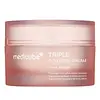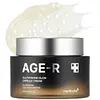What's inside
What's inside
 Key Ingredients
Key Ingredients

 Benefits
Benefits

 Concerns
Concerns

 Ingredients Side-by-side
Ingredients Side-by-side

Water
Skin ConditioningGlycerin
HumectantDipropylene Glycol
HumectantCetearyl Alcohol
EmollientCyclopentasiloxane
EmollientCaprylic/Capric Triglyceride
MaskingTriethylhexanoin
MaskingHydrogenated Polydecene
Emollient1,2-Hexanediol
Skin ConditioningNiacinamide
SmoothingHydrogenated Poly(C6-14 Olefin)
EmollientCyclohexasiloxane
EmollientGlyceryl Stearate Se
EmulsifyingDioscorea Japonica Root Extract
Skin ConditioningAesculus Hippocastanum Extract
AntioxidantLaminaria Japonica Extract
Skin ProtectingEclipta Prostrata Leaf Extract
Skin ConditioningCollagen Extract
Skin ConditioningHydrogenated Lecithin
EmulsifyingArgania Spinosa Kernel Oil
EmollientSodium Hyaluronate
HumectantCetearyl Olivate
C12-16 Alcohols
EmollientDimethicone
EmollientGlyceryl Stearate
EmollientPEG-100 Stearate
Microcrystalline Cellulose
AbsorbentCetearyl Glucoside
EmulsifyingSorbitan Olivate
EmulsifyingFructose
HumectantHydroxyethyl Acrylate/Sodium Acryloyldimethyl Taurate Copolymer
Emulsion StabilisingButylene Glycol
HumectantSqualane
EmollientPalmitic Acid
EmollientBetaine
HumectantCellulose Gum
Emulsion StabilisingHydrolyzed Corn Starch
HumectantPolysorbate 60
EmulsifyingEthylhexylglycerin
Skin ConditioningAdenosine
Skin ConditioningHydrogenated Polyisobutene
EmollientBeta-Glucan
Skin ConditioningAlcohol
AntimicrobialDisodium EDTA
Isononyl Isononanoate
EmollientPolyglyceryl-10 Stearate
Skin ConditioningSorbitan Isostearate
EmulsifyingSucrose
HumectantStearic Acid
CleansingButyrospermum Parkii Butter
Skin ConditioningPolyglyceryl-2 Dipolyhydroxystearate
Skin ConditioningFructooligosaccharides
HumectantInulin Lauryl Carbamate
Emulsion StabilisingHydrolyzed Hyaluronic Acid
HumectantCitric Acid
BufferingDisodium Stearoyl Glutamate
CleansingCollagen
MoisturisingHydrolyzed Elastin
EmollientHyaluronic Acid
HumectantTocopherol
AntioxidantLeuconostoc/Radish Root Ferment Filtrate
AntimicrobialParfum
MaskingPotassium Sorbate
PreservativeLinalool
PerfumingBenzyl Salicylate
PerfumingLimonene
PerfumingHydroxycitronellal
PerfumingWater, Glycerin, Dipropylene Glycol, Cetearyl Alcohol, Cyclopentasiloxane, Caprylic/Capric Triglyceride, Triethylhexanoin, Hydrogenated Polydecene, 1,2-Hexanediol, Niacinamide, Hydrogenated Poly(C6-14 Olefin), Cyclohexasiloxane, Glyceryl Stearate Se, Dioscorea Japonica Root Extract, Aesculus Hippocastanum Extract, Laminaria Japonica Extract, Eclipta Prostrata Leaf Extract, Collagen Extract, Hydrogenated Lecithin, Argania Spinosa Kernel Oil, Sodium Hyaluronate, Cetearyl Olivate, C12-16 Alcohols, Dimethicone, Glyceryl Stearate, PEG-100 Stearate, Microcrystalline Cellulose, Cetearyl Glucoside, Sorbitan Olivate, Fructose, Hydroxyethyl Acrylate/Sodium Acryloyldimethyl Taurate Copolymer, Butylene Glycol, Squalane, Palmitic Acid, Betaine, Cellulose Gum, Hydrolyzed Corn Starch, Polysorbate 60, Ethylhexylglycerin, Adenosine, Hydrogenated Polyisobutene, Beta-Glucan, Alcohol, Disodium EDTA, Isononyl Isononanoate, Polyglyceryl-10 Stearate, Sorbitan Isostearate, Sucrose, Stearic Acid, Butyrospermum Parkii Butter, Polyglyceryl-2 Dipolyhydroxystearate, Fructooligosaccharides, Inulin Lauryl Carbamate, Hydrolyzed Hyaluronic Acid, Citric Acid, Disodium Stearoyl Glutamate, Collagen, Hydrolyzed Elastin, Hyaluronic Acid, Tocopherol, Leuconostoc/Radish Root Ferment Filtrate, Parfum, Potassium Sorbate, Linalool, Benzyl Salicylate, Limonene, Hydroxycitronellal
Water
Skin ConditioningGlycerin
HumectantGlycereth-26
HumectantButylene Glycol
HumectantMethylpropanediol
SolventVinyldimethicone
Niacinamide
Smoothing1,2-Hexanediol
Skin ConditioningBetaine
HumectantIsononyl Isononanoate
EmollientIsohexadecane
EmollientSodium Polyacrylate
AbsorbentAmmonium Acryloyldimethyltaurate/Vp Copolymer
Phenyl Trimethicone
Skin ConditioningDimethiconol
EmollientAroma
Chondrus Crispus Powder
AbrasiveC18-21 Alkane
SolventGlutathione
Ethylhexylglycerin
Skin ConditioningPolyglyceryl-10 Laurate
Skin ConditioningGlyceryl Acrylate/Acrylic Acid Copolymer
HumectantAgar
MaskingXanthan Gum
EmulsifyingHydrogenated Lecithin
EmulsifyingPolyglyceryl-10 Oleate
Skin ConditioningAdenosine
Skin ConditioningTromethamine
BufferingAcrylates/C10-30 Alkyl Acrylate Crosspolymer
Emulsion StabilisingGlucose
HumectantLimonene
PerfumingGellan Gum
Thioctic Acid
AntioxidantCaprylic/Capric Triglyceride
MaskingCeramide NP
Skin ConditioningSorbitan Laurate
EmulsifyingHydroxyethylcellulose
Emulsion StabilisingAcetyl Dipeptide-1 Cetyl Ester
Skin ConditioningPalmitoyl Tripeptide-5
Skin ConditioningAcetyl Hexapeptide-1
Skin ConditioningSoluble Collagen
HumectantWater, Glycerin, Glycereth-26, Butylene Glycol, Methylpropanediol, Vinyldimethicone, Niacinamide, 1,2-Hexanediol, Betaine, Isononyl Isononanoate, Isohexadecane, Sodium Polyacrylate, Ammonium Acryloyldimethyltaurate/Vp Copolymer, Phenyl Trimethicone, Dimethiconol, Aroma, Chondrus Crispus Powder, C18-21 Alkane, Glutathione, Ethylhexylglycerin, Polyglyceryl-10 Laurate, Glyceryl Acrylate/Acrylic Acid Copolymer, Agar, Xanthan Gum, Hydrogenated Lecithin, Polyglyceryl-10 Oleate, Adenosine, Tromethamine, Acrylates/C10-30 Alkyl Acrylate Crosspolymer, Glucose, Limonene, Gellan Gum, Thioctic Acid, Caprylic/Capric Triglyceride, Ceramide NP, Sorbitan Laurate, Hydroxyethylcellulose, Acetyl Dipeptide-1 Cetyl Ester, Palmitoyl Tripeptide-5, Acetyl Hexapeptide-1, Soluble Collagen
 Reviews
Reviews

Ingredients Explained
These ingredients are found in both products.
Ingredients higher up in an ingredient list are typically present in a larger amount.
1,2-Hexanediol is a synthetic liquid and another multi-functional powerhouse.
It is a:
- Humectant, drawing moisture into the skin
- Emollient, helping to soften skin
- Solvent, dispersing and stabilizing formulas
- Preservative booster, enhancing the antimicrobial activity of other preservatives
Adenosine is in every living organism. It is one of four components in nucleic acids that helps store our DNA.
Adenosine has many benefits when used. These benefits include hydrating the skin, smoothing skin, and reducing wrinkles. Once applied, adenosine increases collagen production. It also helps with improving firmness and tissue repair.
Studies have found adenosine may also help with wound healing.
In skincare products, Adenosine is usually derived from yeast.
Learn more about AdenosineBetaine is a common humectant (a substance that promotes retention of moisture). It's known to be gentle on the skin and can help balance hydration.
This ingredient is best for improving hydration and soothing irritated skin. Studies also show it helps even out skin tone.
Fun fact: Betaine is naturally created in the skin and body. The kind found within cosmetic products can be either plant-derived or synthetic.
Another name for betaine is trimethylglycine.
Learn more about BetaineButylene Glycol (or BG) is used within cosmetic products for a few different reasons:
Overall, Butylene Glycol is a safe and well-rounded ingredient that works well with other ingredients.
Though this ingredient works well with most skin types, some people with sensitive skin may experience a reaction such as allergic rashes, closed comedones, or itchiness.
Learn more about Butylene GlycolThis ingredient is an emollient, solvent, and texture enhancer. It is considered a skin-softener by helping the skin prevent moisture loss.
It helps thicken a product's formula and makes it easier to spread by dissolving clumping compounds.
Caprylic Triglyceride is made by combining glycerin with coconut oil, forming a clear liquid.
While there is an assumption Caprylic Triglyceride can clog pores due to it being derived from coconut oil, there is no research supporting this.
Learn more about Caprylic/Capric TriglycerideEthylhexylglycerin (we can't pronounce this either) is commonly used as a preservative and skin softener. It is derived from glyceryl.
You might see Ethylhexylglycerin often paired with other preservatives such as phenoxyethanol. Ethylhexylglycerin has been found to increase the effectiveness of these other preservatives.
Glycerin is already naturally found in your skin. It helps moisturize and protect your skin.
A study from 2016 found glycerin to be more effective as a humectant than AHAs and hyaluronic acid.
As a humectant, it helps the skin stay hydrated by pulling moisture to your skin. The low molecular weight of glycerin allows it to pull moisture into the deeper layers of your skin.
Hydrated skin improves your skin barrier; Your skin barrier helps protect against irritants and bacteria.
Glycerin has also been found to have antimicrobial and antiviral properties. Due to these properties, glycerin is often used in wound and burn treatments.
In cosmetics, glycerin is usually derived from plants such as soybean or palm. However, it can also be sourced from animals, such as tallow or animal fat.
This ingredient is organic, colorless, odorless, and non-toxic.
Glycerin is the name for this ingredient in American English. British English uses Glycerol/Glycerine.
Learn more about GlycerinHydrogenated Lecithin is created from the hydrogenation of lecithin (a group of phospholipids). Hydrogenation is a chemical reaction between hydrogen and another element.
This ingredient is an emollient and emulsifier. As an emollient, it helps soften skin by trapping moisture within. As an emulsifier, it prevents oil and water ingredients from separating.
Isononyl Isononanoate is a synthetic skin-conditioner and texture enhancer. It is created from nonanoic acid, a fatty acid found in cocoa and lavender oil.
As an emollient, Isononyl Isononanoate helps keep your skin soft and smooth. This is because emollients create a barrier on the skin to trap moisture in.
Isononyl Isononanoate helps give products a velvet feel and improves spreadability.
Learn more about Isononyl IsononanoateLimonene is a fragrance that adds scent and taste to a formulation.
It's found in the peel oil of citrus fruits and other plants such as lavender and eucalyptus. The scent of limonene is generally described as "sweet citrus".
Limonene acts as an antioxidant, meaning it helps neutralize free radicals.
When exposed to air, oxidized limonene may sensitize the skin. Because of this, limonene is often avoided by people with sensitive skin.
The term 'fragrance' is not regulated in many countries. In many cases, it is up to the brand to define this term. For instance, many brands choose to label themselves as "fragrance-free" because they are not using synthetic fragrances. However, their products may still contain ingredients such as essential oils that are considered a fragrance.
Learn more about LimoneneNiacinamide is a multitasking form of vitamin B3 that strengthens the skin barrier, reduces pores and dark spots, regulates oil, and improves signs of aging.
And the best part? It's gentle and well-tolerated by most skin types, including sensitive and reactive skin.
You might have heard of "niacin flush", or the reddening of skin that causes itchiness. Niacinamide has not been found to cause this.
In very rare cases, some individuals may not be able to tolerate niacinamide at all or experience an allergic reaction to it.
If you are experiencing flaking, irritation, and dryness with this ingredient, be sure to double check all your products as this ingredient can be found in all categories of skincare.
When incorporating niacinamide into your routine, look out for concentration amounts. Typically, 5% niacinamide provides benefits such as fading dark spots. However, if you have sensitive skin, it is better to begin with a smaller concentration.
When you apply niacinamide to your skin, your body converts it into nicotinamide adenine dinucleotide (NAD). NAD is an essential coenzyme that is already found in your cells as "fuel" and powers countless biological processes.
In your skin, NAD helps repair cell damage, produce new healthy cells, support collagen production, strengthen the skin barrier, and fight environmental stressors (like UV and pollution).
Our natural NAD levels start to decline with age, leading to slower skin repair, visible aging, and a weaker skin barrier. By providing your skin niacinamide, you're recharging your skin's NAD levels. This leads to stronger, healthier, and younger looking skin.
Another name for vitamin B3 is nicotinamide. This vitamin is water-soluble and our bodies don't store it. We obtain Vitamin B3 from either food or skincare. Meat, fish, wheat, yeast, and leafy greens contain vitamin B3.
The type of niacinamide used in skincare is synthetically created.
Learn more about NiacinamideWater. It's the most common cosmetic ingredient of all. You'll usually see it at the top of ingredient lists, meaning that it makes up the largest part of the product.
So why is it so popular? Water most often acts as a solvent - this means that it helps dissolve other ingredients into the formulation.
You'll also recognize water as that liquid we all need to stay alive. If you see this, drink a glass of water. Stay hydrated!
Learn more about Water